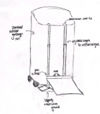Design selection matrix
From DDL Wiki
A design selection matrix, also known as a Pugh chart or Pugh matrix, is a table for helping a design team to systematically compare alternative design concepts against the design criteria and document the evaluation. Design selection matrices are typically used in conceptual design to compare alternative ideas created through concept generation techniques, such as brainstorming.
Contents |
Example
The following hypothetical example examines two design concepts intended to improve the process of emptying a trash can.
Selection Criteria
The selection criteria are listed on the left side of the matrix along the rows of the table. Criteria are usually descriptions of user/customer or stakeholder needs and expectations. Because the design selection matrix is typically used in early conceptual design phases, these criteria are usually subjective and not quantitative. The designer can assign weights to each criterion specifying its degree of importance relative to the others.
Design Alternatives
The columns of the table are used to list each of the designers concepts. A datum is selected as a reference point. It is best if the datum is the most common and familiar of the alternatives. The datum receives scores of zero on all criteria, defining the reference point. Each of the other alternatives are then compared against the datum on each of the selection criteria. Typically a + is given if the alternative is superior to the datum on the specific criterion, a - is given if the alternative is inferior, and a zero is given if the alternative is comparable to the datum. Multiple +'s or -'s can be given to express degree. Working through this process with a team of designers can help to facilitate communication, and the process of working through the matrix can be the most valuable outcome.
Scoring
The total number of +'s, 0's, and -'s for each alternative are tallied after multiplying each by the associated criteria weight. The difference of +'s and -'s can be summed as well to generate a net score. Because so much subjectivity is involved in filling out the matrix, and because somewhat arbitrary scales are used, the net score cannot be used as a certain measure of which item is best. However, when some scores end up much larger or much smaller than others, it is an indication of preference. Scores that are close to one another indicate that the matrix cannot easily rank one above the other; however, the columns of +'s and -'s indicate the strengths and weakness of each alternative. Examination of the strengths and weaknesses can also help designers to think of ways to combine the strengths of multiple concepts into a new design idea.



